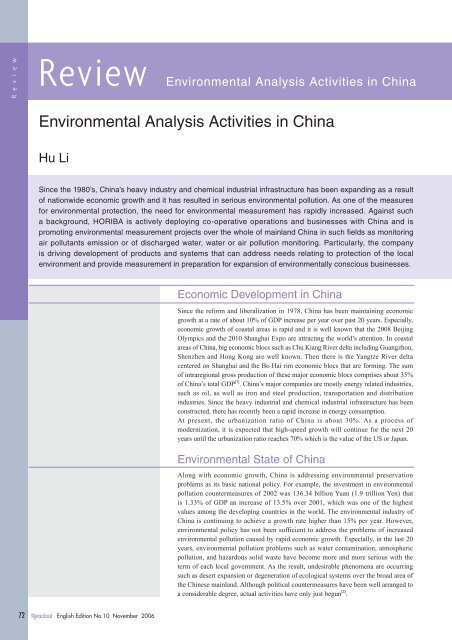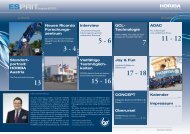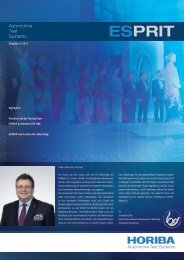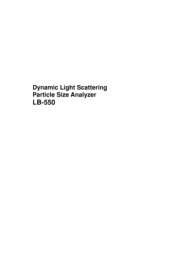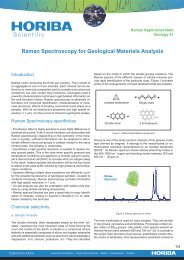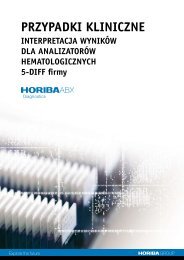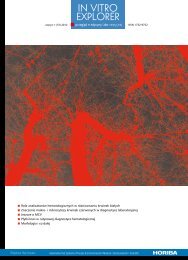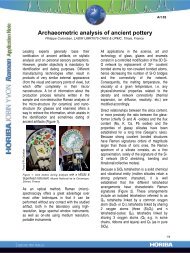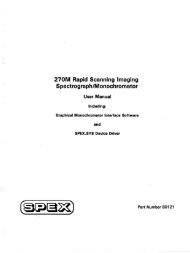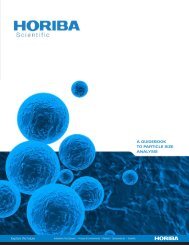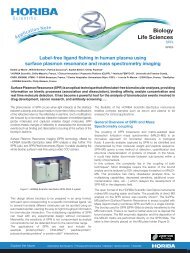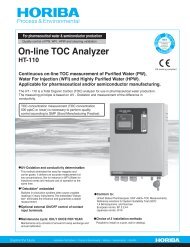Download PDF - Horiba
Download PDF - Horiba
Download PDF - Horiba
You also want an ePaper? Increase the reach of your titles
YUMPU automatically turns print PDFs into web optimized ePapers that Google loves.
R e v i e w<br />
Review Environmental Analysis Activities in China<br />
Environmental Analysis Activities in China<br />
Hu Li<br />
Since the 1980’s, China’s heavy industry and chemical industrial infrastructure has been expanding as a result<br />
of nationwide economic growth and it has resulted in serious environmental pollution. As one of the measures<br />
for environmental protection, the need for environmental measurement has rapidly increased. Against such<br />
a background, HORIBA is actively deploying co-operative operations and businesses with China and is<br />
promoting environmental measurement projects over the whole of mainland China in such fi elds as monitoring<br />
air pollutants emission or of discharged water, water or air pollution monitoring. Particularly, the company<br />
is driving development of products and systems that can address needs relating to protection of the local<br />
environment and provide measurement in preparation for expansion of environmentally conscious businesses.<br />
72 English Edition No.10 November 2006<br />
Economic Development in China<br />
Since the reform and liberalization in 1978, China has been maintaining economic<br />
growth at a rate of about 10% of GDP increase per year over past 20 years. Especially,<br />
economic growth of coastal areas is rapid and it is well known that the 2008 Beijing<br />
Olympics and the 2010 Shanghai Expo are attracting the world’s attention. In coastal<br />
areas of China, big economic blocs such as Chu Kiang River delta including Guangzhou,<br />
Shenzhen and Hong Kong are well known. Then there is the Yangtze River delta<br />
centered on Shanghai and the Bo Hai rim economic blocs that are forming. The sum<br />
of intraregional gross production of these major economic blocs comprises about 35%<br />
of China’s total GDP [1] . China’s major companies are mostly energy related industries,<br />
such as oil, as well as iron and steel production, transportation and distribution<br />
industries. Since the heavy industrial and chemical industrial infrastructure has been<br />
constructed, there has recently been a rapid increase in energy consumption.<br />
At present, the urbanization ratio of China is about 30%. As a process of<br />
modernization, it is expected that high-speed growth will continue for the next 20<br />
years until the urbanization ratio reaches 70% which is the value of the US or Japan.<br />
Environmental State of China<br />
Along with economic growth, China is addressing environmental preservation<br />
problems as its basic national policy. For example, the investment in environmental<br />
pollution countermeasures of 2002 was 136.34 billion Yuan (1.9 trillion Yen) that<br />
is 1.33% of GDP an increase of 13.5% over 2001, which was one of the highest<br />
values among the developing countries in the world. The environmental industry of<br />
China is continuing to achieve a growth rate higher than 15% per year. However,<br />
environmental policy has not been sufficient to address the problems of increased<br />
environmental pollution caused by rapid economic growth. Especially, in the last 20<br />
years, environmental pollution problems such as water contamination, atmospheric<br />
pollution, and hazardous solid waste have become more and more serious with the<br />
term of each local government. As the result, undesirable phenomena are occurring<br />
such as desert expansion or degeneration of ecological systems over the broad area of<br />
the Chinese mainland. Although political countermeasures have been well arranged to<br />
a considerable degree, actual activities have only just begun [2] .
Water Environment<br />
At present, in China, since the processing capacity of domestic waste water<br />
discharged from factories and households is low, water contamination is occurring<br />
over the majority of rivers, lakes and sea coasts. Such phenomena as the death of<br />
water creatures in rivers, damage to fi sh farms or eutrophication of lakes and adjacent<br />
sea are seen everywhere. As shown from the fact that 50% of underground water in<br />
urban areas is contaminated, problems of water shortages are becoming more serious.<br />
Among seven major river systems, degree of contamination is very serious in the Huai<br />
river, Hai river, and Liao river, and especially, along the Huai river water system,<br />
there are such a serious conditions that people can barely obtain drinking water [3] . In<br />
the Chinese Government’s 10th fi ve year plan (2001 to 2005), protection from water<br />
contamination in rivers, lakes and sea coasts is specially focused on, and also in the<br />
11th five year plan (2006 to 2010), the same political measures are expected to be<br />
continued. But, in order to fundamentally improve water quality, great effort should<br />
be expended in the long term by regional government, industrial society, agricultural<br />
workers working in river basins, and so on.<br />
Atmospheric Environment<br />
Coal is a major energy resource providing over 50% of the energy consumed in<br />
China. But, SO 2 gas emissions are the largest in the world exceeding the emissions<br />
of the USA. As a result, acid deposition phenomena are seen over a broad area.<br />
Accompanying relocation of factories from urban areas to suburbs, contributions of<br />
fi xed emission sources to atmospheric pollution is decreasing in urban areas. At the<br />
same time it has been found that the contribution of exhaust gases from vehicles to<br />
atmospheric air is a major cause of environmental pollution in several big cities as the<br />
result of recent moves toward an automobile society.<br />
About Solid Waste<br />
In China, since processing facilities of solid wastes such as domestic garbage,<br />
industrial waste, and polluted sludge is insufficient and they are left unattended in<br />
suburb areas, phenomena such as soil pollution and underground water contamination<br />
are seen over a wide area. At present, landfi lling is mostly used as the main method of<br />
treating solid wastes in China. But, recently, in coastal areas where economic growth<br />
is rapid, many incineration plants for domestic garbage and industrial waste have been<br />
constructed and also refuse incineration power plants have been constructed in several<br />
big cities to address the shortage of electric power.<br />
Status of Environmental Monitoring in China<br />
At present, there are 82 government-constructed automatic monitoring facilities<br />
in rivers, dams, and lakes in major water systems. Monitored environmental<br />
status obtained from these automatic monitoring stations is published weekly in<br />
newspapers [4] . Being actively promoted is continuous monitoring of discharged water<br />
from industry, to measure such parameters as COD *1 , pH, rate of discharge, etc.<br />
Although several thousand COD meters have been installed nationwide, there have<br />
been many instruments that cannot operate stably because of quality problems and<br />
insufficient systems of maintenance. As a measuring method, the shift to the TOC<br />
method *2 and UV method *3 is progressing.<br />
*1: COD means Chemical Oxygen Demand that shows the amount of oxidizing reagent<br />
consumed by converting to an equivalent amount of oxygen when reducing organic materials<br />
in water.<br />
*2: TOC means Total Organic Carbon that is a method to measure the amount of organic carbon<br />
in water by using oxidization to convert it to CO2. *3: UV method is a measurement method using absorption of ultraviolet light.<br />
In 2002, automatic ambient air monitoring stations started operation in 474 places<br />
in 179 cities and a nationwide survey on acid deposition was carried out [5] . As for<br />
continuous monitoring of emitted gas from fixed sources such as thermal power<br />
plants, although there are many plants that use a simple monitoring system, there are<br />
still not so many companies that have installed a Continuous Emission Monitoring<br />
Technical Reports<br />
English Edition No.10 November 2006<br />
73
R e v i e w<br />
Review Environmental Analysis Activities in China<br />
74 English Edition No.10 November 2006<br />
Systems (CEMS). It is expected that companies that install both the desulfurization<br />
system and CEMS will increase in the future.<br />
Attention to acid deposition has become high and China is now engaged in acid<br />
deposition monitoring as part of the Acid Deposition Monitoring Network in East Asia<br />
(EANET). China is monitoring the amount and impact of acid deposition at nine sites<br />
in four cities of Chongqing, Xian, Xiamen and Zhuhai. Nationwide research on acid<br />
deposition is also being carried out.<br />
In order to address various environmental problems, environmental monitoring centers<br />
of national government, province and regional governments, directly controlled cities,<br />
and municipalities are intensively promoting installations of laboratory equipment and<br />
cultivating human resources.<br />
Working on Environmental Business in China<br />
Recently, HORIBA has been developing its business across a broad range of<br />
environmental measurement fi elds in China.<br />
Participation and Co-operation with Activities of JETA<br />
(Japan Environmental Technology Association)<br />
Recently, JETA has been working on international co-operation activities. Especially<br />
in areas of information exchange and co-operation in the field of environmental<br />
measurement technologies with China, many successful results have been obtained.<br />
As a JETA member, HORIBA is actively participating and co-operating in JETA’s<br />
activities.<br />
A delegation lead by the Chairman of JETA, Kozo Ishida who is a vice-president of<br />
HORIBA has visited China several times to discuss and exchange opinions relating<br />
to environmental preservation and measurement issues. Also to discuss future cooperation<br />
and the direction of environmental business development with Mr. Qu<br />
Geping who is a deputy doyen of the All-China Environmnent Federation and<br />
President of the China Environmental Protection Foundation (previously minister<br />
of State Environmental Protection Administration of China), Mr. Wang Xinfang,<br />
who is the Deputy Minister of State Environmental Protection Administration of the<br />
P. R. China, Mr. Wan Bentai, who is Director of the China National Environmental<br />
Monitoring Center, and Han Wei, who is the Deputy Chairman of the China<br />
Environmental Protection Industry Association.<br />
As a result the Japan and China Symposium on limiting and measuring of dioxin<br />
in hazardous waste incineration processes was held at Beijing in August 2004,<br />
jointly hosted by the Ministry of Environment of Japan and State Environmental<br />
Protection Administration of the P. R. China (SEPA) and in co-operation with the<br />
China National Environmental Monitoring Center (CNEMC), Japan Industrial Waste<br />
Treatment Promotion Center (JW), Japan Environmental Sanitary Facilities Industrial<br />
Association (JEFMA) and JETA [6] . The author reported a paper entitled “Reduction<br />
of dioxin emission by controlling CO 2/O 2 concentration of incineration processing”<br />
and introduced experiences in Japan of a continuous measurement system related to<br />
reduction of dioxin emissions by controlling the CO 2/O 2 concentration. In September<br />
2004 the 1st Japan and China Environmental Measurement Technology Symposium<br />
was held at Dalian by a joint hosting of JETA and CNEMC. At this symposium,<br />
HORIBA reported exhaust gas monitoring technology from fixed emission sources<br />
and also water contamination monitoring technology. In December 2004 the “Japan<br />
and China water quality continuous measurement technology seminar” was held at<br />
Shignseng of Guangdong province by a joint hosting of JETA and CNEMC. HORIBA<br />
summarized and reported research results from China on COD measurement using a<br />
UV method.<br />
HORIBA has been dispatching a researcher to Acid Deposition and Oxidant Research<br />
Center (ADORC) that is also a network center of Acid Deposition Monitoring
Network in East Asia (EANET) since trials started in April 1998. At present, the 3rd<br />
dispatched researcher is actively working at the ecological impact research department<br />
of ADORC. Also, the author has visited Beijing, Chongqing, Xian, Amoy and Zhuhai<br />
that are participating cities to EANET as its operation in China to conduct a field<br />
survey as well as to exchange information and to execute technical assistance, through<br />
which the author could contract a good friendship with SEPA and CNEMC people.<br />
Emission Gas and Ambient Air Measurement Systems<br />
HORIBA’s emission gas measurement equipment (for fixed and mobile emission<br />
sources) and ambient air measurement equipment have been introduced to the Japan<br />
and China Friendship Environmental Preservation Center as a symbol of co-operative<br />
work between them and has been in use for some time. HORIBA has been offering<br />
free after-service for this equipment as part of co-operative work and has been highly<br />
appreciated and valued by CNEMC.<br />
In China, as a countermeasure against air pollution, needs for emission gas monitoring<br />
from fi xed emission sources such as thermal power plants is increasing. To address<br />
these needs, HORIBA obtained a certification from the China Measurement Law<br />
for stack gas measurement equipment in 2001. HORIBA has developed the ENDA-<br />
600ZG series of CEMS that is possible to be compatible with Chinese standard.<br />
Together with an engineering company in Beijing, installed it in the Huangdao<br />
power plant in Qingdao city in September 2002, and received a certification from<br />
SEPA certifi cation center. Further in March 2003, HORIBA received a certifi cation<br />
issued from the China Environmental Protection Industry Association. In spring of<br />
2003, HORIBA received an order from the Chongqing city fi xed emission source gas<br />
monitoring system as part of a yen-credit project. At present, 25 installations of this<br />
system are working at sites such as the thermal power plants of Chongqing city, etc. In<br />
addition, HORIBA is selling 100 sets of stack gas measurement equipment per year in<br />
co-operation with local engineering companies of Beijing. Figure 1 shows a 300 MW<br />
thermal power plant of Zao Zhuang City in Shandong Province to which an ENDA-<br />
600ZG series has been installed.<br />
In China’s electrical power industry, also CEMS using a dilution method is widely<br />
used. The ambient air measurement equipment that HORIBA is supplying to local<br />
engineering companies in China has been widely adopted by many companies as a<br />
dilution-method CEMS because of its high performance and quality.<br />
At present, electrochemical type sensors are mostly provided in the portable stack<br />
gas analyzer market in China. But, since HORIBA’s portable stack gas analyzer<br />
PG-250 features a continuous measurement capability, stability and high accuracy,<br />
certifi cations from the China Measurement Law and China Environmental Protection<br />
Industry Association were obtained to address the demands from the market.<br />
Excellence of this product was also recognized by the China Environmental Protection<br />
Offi ce’s Certifi cation Center and the products were introduced to this center. We are<br />
expecting that this product will be rapidly introduced into the market.<br />
HORIBA is actively developing the market in the filed of ambient air monitoring.<br />
In collaboration with regional Chinese companies, HORIBA is developing an<br />
automatic environmental air pollution monitoring system that can address the regional<br />
needs to expand this market. Required for the acid deposition problem is automatic<br />
measurement equipment to measure concentrations of acidic gases and PM10 *4 for<br />
dry deposition. Since HORIBA has rich experience and data in this fi eld also, we will<br />
surely be able to contribute to solving China’s acid deposition issue.<br />
Movement of China toward an automobile society has greatly infl uenced atmospheric<br />
air in big cities. The author presented a report about the purpose, role and system<br />
construction of automobile emission gas measurement station at “National meeting<br />
on automobile emission gas measurement in important cities” held in 2004 sponsored<br />
by SEPA and got a great attention of many attendants. HORIBA believes that the<br />
company will be able to contribute for improving the air pollution issue in big cities of<br />
China utilizing its abundant know-how about this fi eld.<br />
*4: Particulate matter having a diameter less than 10 μm.<br />
Technical Reports<br />
Figure 1 300 MW Thermal Power Plant of Zao<br />
Zhuang City in Shandong Province<br />
(ENDA-600ZG series has been<br />
installed)<br />
English Edition No.10 November 2006<br />
75
R e v i e w<br />
Review Environmental Analysis Activities in China<br />
Figure 2 Automatic Measurement Station<br />
of Environmental Water Quality at<br />
the Shenzhen City’s Dam Site in<br />
Guangdong Province<br />
76 English Edition No.10 November 2006<br />
Water Quality Monitoring Field<br />
Before filling Sanxia Dam, the world’s largest dam with water, CNEMC measured<br />
the water quality of the Sanxia dam water system using the U-10 portable water<br />
quality checker. We were highly praised for our speed of providing equipment and<br />
the stable and accurate data acquisition capability of the product. In the fi eld of COD,<br />
continuous measurement of industrial wastewater, COD Cr method *5 has been adopted<br />
as an officially recognized method in China. However, although many continuous<br />
measurement devices using the COD Cr method have been installed, there are not many<br />
devices that are normally operating in the fi eld.<br />
In Japan, the COD Mn method *6 , UV method, TOC method and TOD method *7 have<br />
been adopted for continuous measurement of COD values. Especially, since the UV<br />
method has such benefi ts as simple, easy maintenance and low maintenance cost, it<br />
has been adopted in about 80% of COD meters [7] . Utilizing our experiences and knowhow<br />
in Japan, we have carried out research and dissemination activities to contribute<br />
to environmental preservation in China. JETA has participated in two-years’ joint<br />
research in a comparison survey on the environmental water quality of Chu Kiang<br />
river basin, Guangzhou city sewage disposal plant and 4 industries’ discharged<br />
water in co-operation with South China Environmental Science Research Institute<br />
and Guangzhou city Pan Yu district Environmental Monitoring Station. HORIBA<br />
dispatched two professionals and executed comparison surveys between the UV<br />
method COD meter OPSA-120 and the COD Cr analyzer to confi rm availability of the<br />
UV method in China. We obtained a good correlation between water samples from the<br />
Chu Kiang river and fi ve kinds of discharged water from industry [8] .<br />
In addition, as a part of comparison survey between CNEMC’s UV method and the<br />
COD Cr method, an engineering company from Shenzhen installed an OPSA-120 at the<br />
water outlets of sewage disposal plants of about 10 companies including dye works,<br />
a food company and PCB company, etc. While the Shenzhen City Environmental<br />
Monitoring Center executed several months of comparison surveys between COD<br />
values obtained by the COD Cr method and UV method. The result of this survey<br />
was fairly good and showed a good correlation. Also high stability of the installed<br />
equipment was endorsed [9] . Since the operation of the UV method is very stable, it was<br />
highly evaluated at the meeting on wastewater quality monitoring held by Guangdong<br />
province’s environmental continuous monitoring project.<br />
In Summer 2003, HORIBA installed an OPSA-120 system which uses the UV method<br />
at the sewage disposal plant of a food company in Yunnan district together with local<br />
engineering company in collaboration with the Yunnan Environmental Monitoring<br />
Center and obtained a good correlation with the result of the COD Cr method. At<br />
present, it is still working stably two years after its installation. This result has been<br />
highly endorsed by Yunnan District’s Environmental Protection Bureau and quotation<br />
requests about this system from companies in Yunnan district are increasing. At<br />
present, in the market for this type of COD continuous measurement equipment,<br />
HORIBA’s OPSA-120 system is occupying over 50%.<br />
HORIBA’s OPSA-120 has also been installed as the continuous measurement station<br />
of environmental water quality at the Shenzhen river site. Water from Shenzhen river<br />
is blackish, dirty and bad-smelling, so many measurement errors have occurred when<br />
using other measurement equipment, while HORIBA’s system is stably providing the<br />
data. From this achievement, we are expecting the future expansion of this type of<br />
COD analyzer market.<br />
In August 2004, an engineering company in Shenzhen installed an automatic<br />
measurement station (Figure 2) consisting of HORIBA’s water quality monitoring<br />
equipment, TPNA-300 (Monitoring total Nitrogen and total Phosphorus), UV method<br />
type OPSA-120, and multiple water quality checker U-20 series at the Shenzhen city’s<br />
dam site. This system is stably providing good data. In future, the system will become<br />
a good model of an automatic water quality monitoring station and its use is expected<br />
to spread to other districts.


